Sur and Taal in the Land of Rhythm and Blues
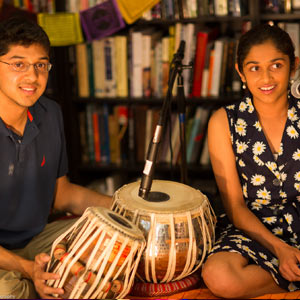
(Left) 2014 IndianRaga Fellows from the Bay Area, Aditya Srivatsan and Geeta Shankar, are all smiles at a jamming session in New York. (Photo: Vladimir Weinstein)
Indian classical music now competes with several genres of world music in this age of global influences. It faces an uphill battle in finding fans amongst the newer generations. If that’s the case in the motherland, imagine how much harder it is to keep the flame of this music alive amongst young Indian-Americans. And yet that is precisely what IndianRaga has managed to do—with an award-wining concept that is making savvy use of technology to revolutionize this genre, and in the process, attracting many youngsters to this age old tradition.
Mention Indian classical music and it conjures up images of vocalists such as Pandit Jasraj, Bhimsen Joshi, and Balamurali Krishna, and instrumentalists such as Amjad Ali Khan, Hariprasad Chaurasia, and T. N. Krishnan—legendary virtuosos of an era fast morphing into the past.
How can this glorious legacy be sustained in our fast-paced world? Let’s face it, our lives are busy, and our attention spans short. We consume music mostly on the run—while riding the subway, or driving, or folding laundry between cooking and cleaning. How could the rigorous art form of Hindustani or Carnatic music sustain, let alone flourish, in our hectic environment? After all, this is music characterized by lengthy performances from practitioners who have clocked long, arduous hours of riyaz. How could the growing new generations be drawn to it? And even if they were somehow drawn to it, how could they be trained, considering not all of them are fortunate to be living close to the small number of teachers of such art forms?
In a stroke of brilliance, a couple of years back, a couple of MIT students, Sriram Emani and Anasuya Mandal, who were passionate about Indian classical music, came up with a prize-winning solution to do precisely all of that, and thus was born “IndianRaga.”
Simple in concept, IndianRaga was radical in its departure from custom. At the risk of oversimplification, it can be said, IndianRaga employed two distinct strategies, because of which today there are hundreds of youngsters around America who are enjoying learning this music and showcasing their talent to a growing audience across the globe: (1) Keeping in mind the incompatibility and limited reach of the lengthy traditional concert in today’s frenetic lifestyles, it created several short, 4-5 minute music videos of vocalists and instrumentalists and offered them for consumption on the internet. (2) They overcame the physical distance between the tutor and the student by offering classical music training through Skype and other video conferencing solutions. Soon, students were learning from the comfort of their suburban American homes.
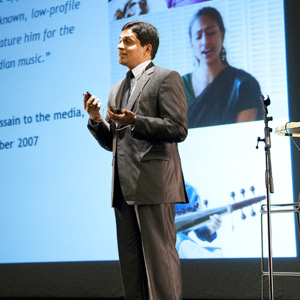
Founder Sriram Emani presenting IndianRaga at the Global Creative Business Cup in Copenhagen, Denmark.
Talking about the germination of IndianRaga, Emani, co-founder and CEO says, “The desire to find a way to empower young musicians and make Indian classical music more relevant today was there for over a decade. The idea of IndianRaga was, however, born when I was taking a class at MIT Media Lab, where we were being encouraged to use digital media and technology innovatively. I wrote the business plan for IndianRaga as part of the final course, and it went on to win the MIT IDEAS Global Challenge and the US Creative Business Cup. Before we knew it we had launched!”
In theory, the concept was quite simple, and a natural progression of the technology of our times. But it is in the finer nuances of its application that IndianRaga has found its success. It’s one thing to offer short music videos online, and altogether another to be able to generate half-a-million hits for them, considering how highly specialized the genre is. Using technology as a driving force, IndianRaga widened their platform and offerings. They employed sophisticated recording technology and portable smartphone apps such as itablapro, itanpura, and pocketraga that, at the touch of a button, could create the required musical environment for practice. With commitment, single-minded focus and hard work, many youngsters emerged as skilled musicians within a short span of time.
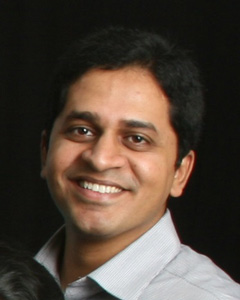
The core team of IndianRaga Fellowship: Sriram Emani, Kiran Borra, and Jayashree Venkatesh.
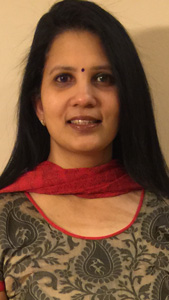
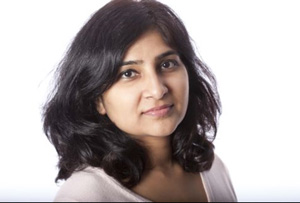
The Fellowship
Thanks to a talented team, the recognition that came from awards, and the optimum use of technology, an infrastructure to advance classical music amongst new and previously unlikely takers had been successfully created. What was missing was a platform to exhibit the talent of the budding artists.
And so, in 2013, IndianRaga launched a nationwide
competition open to all practitioners of Indian classical music. The goal was to foster a community of
Fellows (student instructors) working to create accessible music rooted in classical and folk traditions.
The winners of this competition traveled to New York City for a Fellowship Week that showcased their talents and provided them with strong performance and networking opportunities. They also attended master classes with established teachers of contemporary and classical music and dance traditions. Out of this rich, creative mélange emerged brief, finely crafted music videos, visual moments that captured the skills, youthful vibe, and spontaneous charm of the event. The videos were an instant hit among audiences around the world and won rave reviews from viewers. IndianRaga had arrived.
Further fine-tuning and expansion followed in the January 2014 edition of the music competition. The number of entries jumped to 250, doubling from the previous year. There was a significant rise in the quality of music submitted. In the final round, participants were also tasked to compose an original music track to accompany a mute video.
The 11 winners of the 2014 Fellowship came from eight cities across the USA. IndianRaga’s 2014 Fellowship winners are typical of their generation—extraordinarily bright, comfortable with both tradition and technology and passionate about their art.
Chinmayee Nagaraj, who comes from a musically oriented family in India, has trained under Kalyani Sharma (Mumbai) and Vidwan T. M. Krishna. Now working as a Cincinnati-based genetic counselor, Chinmayee reminisces about the days leading up to the competition: “Prior to meeting in person in New York City in the summer of 2014, we brainstormed ideas for collaboration at Google Hangouts, actively communicated via an email thread sharing music clips and videos that appealed to us. I was introduced to the unique jugalbandi known as Jasrangi by my Hindustani fellow vocalist counterpart Anjana. Together, we explored ideas of singing ragas common to the twin systems of music, namely Hindustani and Carnatic.”
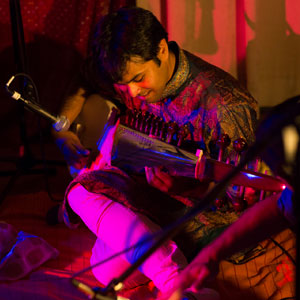
2014 IndianRaga Fellow, sarod player Souryadeep Bhattacharyya from Atlanta. (Photo: Vladimir Weinstein)
Chinmayee’s counterpart, Anjana Chandran from Fremont, California, all of 14 years, won in the 2014 Hindustani Classical Vocal category. Her recollections of the IndianRaga experience at New York capture the spontaneity and creativity that flowered during the event: “It was wonderful to interact with fellows who had different points of view about music. I was able to learn from Fellows who were a little older than me and had gained experience as performers and particularly enjoyed exchanging ideas with Sarod player Souryadeep Bhattacharya and Carnatic vocalist Chinmayee Nagaraj. I came away learning that Indian classical music is not limited to just a few genres. When one brings the elements of voice and instruments and different musical genres together, one is able to create something out-of-the-box! I worked with Chinmayee on Meera bhajan “Barse Badariya” originally sung by legendary vocalist M.S. Subbalakshmi. We added our own ideas in creating a video that featured us along with other fellows playing various instruments, and I was very happy with the outcome.”
IndianRaga Fellows have gone on to do the organization proud, winning prestigious awards in their genre such as Carnatic Music Idol, Cleveland Aradhana, and Chennai December Season awards. Some Fellows have been invited to lecture at Juilliard, Berklee and other reputed music institutes; others have received requests to perform at leading festival concerts.
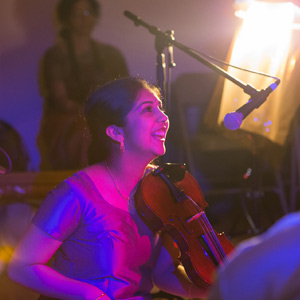
2014 IndianRaga Fellow Sharada Krishnan from New Jersey during an IndianRaga video shoot. (Photo: Vladimir Weinstein)
Thrilled as he is with the response to IndianRaga, Emani is also very focused on the need to consistently produce quality, path breaking work to grow and sustain the enterprise. “The music compositions must challenge them. The videos must also test their ability to capture the essence of a raga in less than 4 minutes, tell a story, and also communicate emotions rather than just recalling and rendering traditional music compositions in a mechanical fashion. The idea is to make our traditional music new-age music by packaging it in an appealing manner,” he says.
Some of this initiative is in response to appeals from music loving families. “Parents have busy schedules and have been asking for online music lessons for their children. We also heard from them that their children are reluctant to practice music in their spare time. And so, we want to explore ways to make practice more interesting and appealing. Additionally, there is a definite market for adults who may have lost touch with music due to academics, work or family pressures and would now like to resume learning music. Online music lessons or videos would be of great help to them.”
According to Emani, an even more fascinating concept, new to Indian classical arts, is “storytelling through music,” made possible by the video format and one that draws in new audiences. The genius of IndianRaga is that they built it around what their target audience—the young—were already into: music videos.
Take one such music video titled “Sunsets” produced by the Fellows of IndianRaga. Featuring all around exceptional production, quality filming, and nuanced acting, “Sunsets” stirs emotions that can be enjoyed by anyone—whether a connoisseur of classical music or not. The description of the video by IndianRaga says it all about its effectiveness in furthering the cause of this genre:
Sunsets seeks to demonstrate the ability of Indian classical music to bring to life the complicated human emotions of loss, separation, memory, and nostalgia. By attempting to seamlessly blend Carnatic and Hindustani forms–alaap, thaanam, bandish, kalpana swaram, koraippu, and korvai–the piece unifies aesthetic approaches in the hope of rising above the limitations of classical grammar and showcasing the sheer beauty of the classical form itself. Using objects of sentiment—the baseball of a young boy, the necklace of a woman, and the tie of a professional—the video catches three individuals in the precious moment of catharsis, where they make the decision to move beyond their attachment to the past and embrace resolution. The ragas Hamsadhwani, and Puriya Dhanashri/ Panthuvarali, each uniquely powerful and poignant, serve as a melodic backdrop, chosen for their simultaneous familiarity and grandeur.
Purist perspective
It’s a brave, new world that IndianRaga has
opened up for the arts. But how does the old guard feel about this radical departure from traditional ways of teaching, learning, and appreciating classical music?
“Skeptical” about sums it up.
Pandit Ujjal Banerjee, a Kolkata-based Hindustani vocalist, feels that in the process of popularizing classical music, its essence may be diluted or sacrificed. Others believe that classical music aficionados will be subjected to compromised standards since modern technology can potentially use techniques that change the original quality of the music in order to create a desired effect. The traditional point of view is that classical music and popular music are distinct from each other with differing purposes, and they should be left that way.
Emani and team, however, aren’t fazed by such opinions. For one, they aren’t the first to break with custom. In the early 1900s, says Emani, Abdul Karim Khan delivered powerful classical music that captured the essence of ragas in LP recordings that were less than five minutes in length.
There’s another good reason, too, for altering the historical format of classical music. “Interest in traditional formats of Indian classical music has been plateauing due to short attention spans, proliferation of digital media, and new visual formats. IndianRaga is pioneering a new wave of content created for these needs—short form content, accessible on all devices, and in well produced visual formats—all the while keeping the focus on pure, authentic classical music. This is increasing the viewership to a younger audience, ensuring the sustainability of pure classical music when it is made relevant to the times,” says Emani emphatically.
The confluence of bright minds with a strategic vision, the participation of outstanding young talent, and the freedom to experiment that technology provides is a recipe for creative magic. Watch any IndianRaga music video and you can’t help being drawn to the skill on display, and the very perceptible passion for art. Besides, everyone seems to be having so much fun!
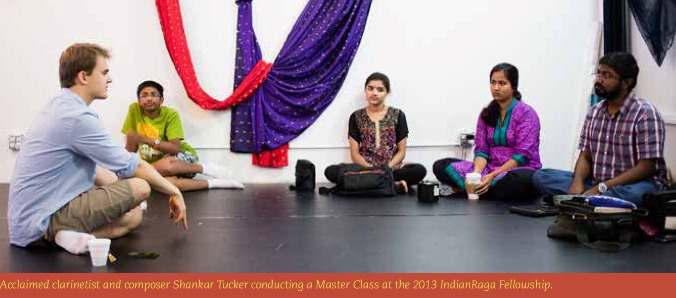
Shuchita Rao is a Hindustani vocalist from Boston, Massachusetts. She enjoys freelancing on subjects related to Indian music, art, and culture.
Enjoyed reading Khabar magazine? Subscribe to Khabar and get a full digital copy of this Indian-American community magazine.
blog comments powered by Disqus










